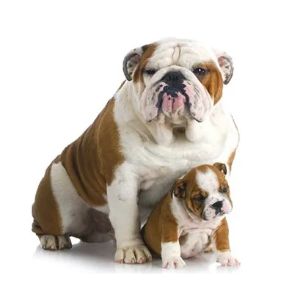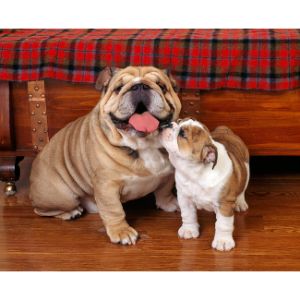
Are you interested how many puppies English Bulldogs have? There are usually 3 to 4 puppies in an English Bulldog litter. Some English Bulldog breeds can have more than four puppies in a litter, but this will result in serious health issues and the puppies may not survive outside the womb. In general, English Bulldogs have smaller litters and shorter lifespans than the average dog for its size.
Several factors can affect a dog’s litter size, including the breed, size, nutrition, and the size of the litter. There is a difference between the average and English Bulldog litter size.
Other articles you would like: Do English Bulldogs Have Breathing Problems? and What Is Cherry Eye In English Bulldogs?
How Many Litters Can An English Bulldog Have?

There should be no more than three breedings in an English Bulldog’s lifetime to ensure its health and well-being. More than three litters in an English Bulldog can present health and welfare problems.
Dogs generally live up to eight years on average, which is shorter than other breeds. Due to their fertile status beginning at around six months, it would probably be best to spread out the breeding process and pregnancies throughout their lives.
Purchasing an English Bulldog might not be the right choice for you if you’re looking to breed many litters.
Why Do Bulldogs Have Small Litters?

Litters are smaller when the dogs are smaller. German Shepherds and Golden Retrievers, which have much wider hips and a larger frame, typically have eight puppies per litter, because they’re large breeds. According to the American Kennel Club, the average litter size is 5-6 puppies.
Because of their larger wombs, they can carry up to eight babies without adversely affecting their development or their mothers’ health.
Take into consideration smaller breeds such as Yorkshire Terriers and English Bulldogs, which have litters on average of three puppies.
The significantly smaller hips, bodies, and wombs of these animals mean they cannot carry and support large litters to the same extent as their larger canine counterparts.
How Can I Tell If My English Bulldog Is Pregnant?
The best way to find out if your bulldog is pregnant is to get an ultrasound. You should request an ultrasound 25 days after mating. English Bulldog ultrasound scanning is the quickest way to determine if your mating and conception plan worked.
If you can wait at least 25 days after mating or artificial insemination, veterinarians recommend you do a pregnancy test as soon as 21 days after mating or artificial insemination.
Timid dogs may find ultrasounds frightening, as they are noninvasive and painless. Your English Bulldog’s belly will need to have some hair removed. The noise may stress her out a bit.
You will be able to see if any puppies are growing inside and how many puppies to expect. You can also come up with a prenatal plan for your dog once you know she is pregnant.
How Can You Tell If A Bulldog Is Ready To Give Birth?

Experienced breeders who understand the female cycle don’t have to guess bulldog due dates. When delivering a bulldog, the window for a c-section can range from 60 days to 63 days, depending on the gestation period.
Puppies can be born early, but veterinarians often perform x-rays or sonograms to track their development.
Early detection of a problem is typical if it exists. The rectal temperature of your dog during the final week of her pregnancy indicates when the puppies will be born.
Drop-In Body Temperature
The temperature of your dog should be between 100 and 101 degrees Fahrenheit if the dog is healthy. When your dog’s thermometer reading stays above this range for two days before labor begins, she is likely preparing to give birth.
After the second reading of a low temperature, labor should commence within 24 hours.
Milk Production
Similar to humans, females provide milk to their pups shortly after birth. Their bodies prepare themselves for birth before even giving birth. In addition to swollen breasts, your dog may have swollen nipples and even some redness around the area.
Panting
When dogs exert themselves physically, they often pant. When dogs exert themselves physically, they tend to pant. It is common to see dogs pant excessively during active labor, with many short breaths that are followed by small pauses.
Lethargy
Your dog may need to rest a great deal as she gets ready to give birth as labor is a draining process. Your dog may be reaching the end of her pregnancy if she seems more sluggish than usual.
Nesting Behavior
It is easy to tell when pregnant dogs are nesting by the behavior they exhibit. To create a safe space for giving birth, your dog may begin digging through pillows, blankets, and any other comfortable items.
By familiarizing your dog with a nesting box before this happens, it will be easier for you to provide a haven for her. However, there’s no guarantee she’ll use it when it’s time.
Loss of Appetite or Vomiting
It’s common for a dog to refuse to eat within the 24-48-hour period following conception or to vomit back up the food she consumes. Your dog’s internal organs, such as the stomach and intestines, are under pressure while the puppies are being born.
Be sure to give your dog plenty of water if she starts vomiting before or during labor. This will prevent dehydration.
Anxiety
Your dog may be in labor if she doesn’t seem to be getting comfortable or keeps pacing. You must be available to your dog during the birthing process for the simple fact that she may instinctively cling to your side.
Do All English Bulldogs Need A C-Section?

A bulldog’s large, round skull makes intervention-free births impossible, but its females’ small pelvis bones make it impossible to deliver without surgery.
It depends on where you live and who you go to for a c-section whether it will cost you more or less.
The information below will help you understand everything you need to know about c-sections and bulldogs, including how they can be performed safely and comfortably and why it is necessary.
In bulldogs, natural birth can pose severe risks to their mothers and puppies. It is usually impossible for puppies to descend properly into the birth canal due to their size and shape.
When they get into the canal, they will probably get stuck. The female and puppies can die if a licensed and trained veterinarian doesn’t intervene.
How Can You Help A Bulldog During Labor?
Even though it is technically not necessary for you to assist your dog during delivery, it is always a good idea to be prepared in case of an emergency. Also, need to tend to the puppies after birth if your mommy dog doesn’t show any interest in them.
The umbilical cord can be cut, the membrane can be removed, a towel can be used to rub the baby, and the baby can be kept warm. It may be necessary to bottle feed the puppies if you are unable to get them to latch on to their mother’s milk.
In addition, your female dog may require assistance walking and urinating after giving birth.
When Can Bulldogs Be Bred?

The process of “heating up” or entering “season” usually begins when dogs reach approximately six to twenty-four months of age. Bulldogs often begin going into heat between six and eight months of age.
The first estrus is not a good time to breed your Bulldog. To ensure that she is physically and mentally prepared for a litter of puppies, we recommend waiting until her third estrus.
A watchful eye should be kept on her when she is in active heat to prevent unplanned breeding. A healthy and happy English bulldog requires at least three breedings throughout its lifetime to stay in good health.
English bulldogs may have serious health and welfare problems, even if they have been living with the same family for years. As for males, they usually reach full sexual maturity between the ages of 12 and 15 months after becoming fertile.
It is not technically necessary for you to assist your dog is giving birth to her puppies, but you should be on hand in case a veterinarian is required in an emergency.
If your mother’s dog is uninterested in her puppies after birth, you may have to tend to them yourself. The umbilical cord may be cut, the membrane may be removed, a towel could be rubbed over them, and they may be kept warm.
In addition, you may need to bottle feed the puppies if you can’t get them to latch on to their mothers. In addition to urinating and walking, your female dog may need assistance after giving birth.
You will also like:
- Do English Bulldogs Shed?
- English Bulldog Vs. French Bulldog
- How To Tell If Your English Bulldog Is Pregnant
For more information about the English Bulldog Breed, check out the video below:




